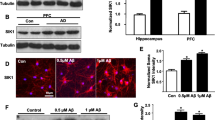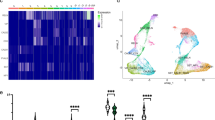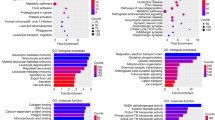Abstract
Perisomatic GABAergic synapses onto hippocampal pyramidal cells arise from two populations of basket cells with different neurochemical and functional properties. The presence of the dystrophin–glycoprotein complex in their postsynaptic density (PSD) distinguishes perisomatic synapses from GABAergic synapses on dendrites and the axon-initial segment. Targeted deletion of neuroligin 2 (NL2), a transmembrane protein interacting with presynaptic neurexin, has been reported to disrupt postsynaptic clustering of GABAA receptors (GABAAR) and their anchoring protein, gephyrin, at perisomatic synapses. In contrast, targeted deletion of Gabra2 disrupts perisomatic clustering of gephyrin, but not of α1-GABAAR, NL2, or dystrophin/dystroglycan. Unexpectedly, conditional deletion of Dag1, encoding dystroglycan, selectively prevents the formation of perisomatic GABAergic synapses from basket cells expressing cholecystokinin. Collectively, these observations suggest that multiple mechanisms regulate formation and molecular composition of the GABAergic PSD at perisomatic synapses. Here, we further explored this issue by investigating the effect of targeted deletion of Gabra1 and NL2 on the dystrophin–glycoprotein complex and on perisomatic synapse formation, using immunofluorescence analysis with a battery of GABAergic pre- and postsynaptic markers. We show that the absence of α1-GABAAR increases GABAergic synapses containing the α2 subunit, without affecting the clustering of dystrophin and NL2; in contrast, the absence of NL2 produces highly variable effects postsynaptically, not restricted to perisomatic synapses and being more severe for the GABAAR subunits and gephyrin than dystrophin. Altogether, the results confirm the importance of NL2 as organizer of the GABAergic PSD and unravel distinct roles for α1- and α2-GABAARs in the formation of GABAergic circuits in close interaction with the dystrophin–glycoprotein complex.





Similar content being viewed by others
References
Baudouin S (2014) Heterogeneity and convergence: the synaptic pathophysiology of autism. Eur J Neurosci 39:1107–1113
Benke D, Mertens S, Trzeciak A, Gillessen D, Mohler H (1991) GABAA receptors display association of gamma2-subunit with alpha1- and beta2/3 subunits. J Biol Chem 266:4478–4483
Benke D, Honer M, Michel C, Mohler H (1996) GABAA receptor subtypes differentiated by their gamma-subunit variants: prevalence, pharmacology and subunit architercture. Neuropharmacol 35:1413–1422
Brown L, Nicholson M, Arama J, Mercer A, Thomson A, Jovanovic J (2016) γ-Aminobutyric acid type A (GABAA) receptor subunits play a direct structural role in synaptic contact formation via their N-terminal extracellular domains. J Biol Chem 291:13926–13942
Brünig I, Suter A, Knuesel I, Luscher B, Fritschy JM (2002) GABAergic presynaptic terminals are required for postsynaptic clustering of dystrophin, but not of GABAA receptors and gephyrin. J Neurosci 22:4805–4813
Budreck EC, Scheiffele P (2007) Neuroligin-3 is a neuronal adhesion protein at GABAergic and glutamatergic synapses. Eur J Neurosci 26:1738–1748
Celio MR (1990) Calbindin D-28 k and parvalbumin in the rat nervous system. Neuroscience 35:375–475
Dumoulin A, Rostaing P, Bedet C, Levi S, Isambert MF, Henry JP, Triller A, Gasnier B (1999) Presence of the vesicular inhibitory amino acid transporter in GABAergic and glycinergic synaptic terminal boutons. J Cell Sci 112:811–823
Fremeau RT, Burman J, Qureshi T, Tran CH, Proctor J, Johnson JA, Zhang H, Sulzer D, Copenhagen DR, Storm-Mathisen J, Reimer RJ, Chaudhry FA, Edwards RH (2002) The identification of vesicular glutamate transporter 3 suggests novel modes of signaling by glutamate. Proc Natl Acad Sci USA 99(22):14488–14493
Fritschy JM, Mohler H (1995) GABAA-receptor heterogeneity in the adult rat brain: differential regional and cellular distribution of seven major subunits. J Comp Neurol 359:154–194
Fritschy JM, Panzanelli P, Tyagarajan SK (2012) Molecular and functional heterogeneity of GABAergic synapses. Cell Mol Life Sci 69:2485–2499
Früh S, Romanos J, Panzanelli P, Bürgisser D, Tyagarajan S, Campbell K, Santello M, Fritschy J (2016) Neuronal dystroglycan is necessary for formation and maintenance of functional CCK-positive basket cell terminals on pyramidal cells. J Neurosci 36:10296–10313
Fukaya M, Kamata A, Hara Y, Tamaki H, Katsumata O, Ito N, Takeda S, Hata Y, Suzuki T, Watanabe M, Harvey RJ, Sakagami H (2011) SynArfGEF is a guanine nucleotide exchange factor for Arf6 and localizes preferentially at post-synaptic specializations of inhibitory synapses. J Neurochem 116:1122–1137
Gunther U, Benson J, Benke D, Fritschy JM, Reyes GH, Knoflach F, Crestani F, Aguzzi A, Arigoni M, Lang Y, Bluethmann H, Mohler H, Luscher B (1995) Benzodiazepine-insensitive mice generated by targeted disruption of the g2-subunit gene of g-aminobutyric acid type A receptors. Proc Natl Acad Sci USA 92:7749–7753
Hoon M, Soykan T, Falkenburger BH, Hammer M, Patrizi A, Schmidt KF, Sassoè-Pognetto M, Löwel S, Moser T, Taschenberger H, Brose N, Varoqueaux F (2011) Neuroligin-4 is localized to glycinergic postsynapses and regulates inhibition in the retina. Proc Natl Acad Sci USA 108:3053–3058
Kasugai Y, Swinny JD, Roberts JD, Dalezios Y, Fukazawa Y, Sieghart W, Shigemoto R, Somogyi P (2010) Quantitative localisation of synaptic and extrasynaptic GABAA receptor subunits on hippocampal pyramidal cells by freeze-fracture replica immunolabelling. Eur J Neurosci 32(11):1868–1888
Kerti-Szigeti K, Nusser Z (2016) Similar GABAA receptor subunit composition in somatic and axon initial segment synapses of hippocampal pyramidal cells. Elife 5:e18426
Klausberger T, Marton L, O’Neill J, Huck J, Dalezios Y, Fuentealba P, Suen WY, Papp E, Kaneko T, Watanabe M, Csicsvari J, Somogyi P (2005) Complementary roles of cholecystokinin- and parvalbumin-expressing GABAergic neurons in hippocampal network oscillations. J Neurosci 25:9782–9793
Knuesel I, Mastrocola M, Zuellig RA, Bornhauser B, Schaub MC, Fritschy JM (1999) Altered synaptic clustering of GABAA-receptors in mice lacking dystrophin (mdx mice). Eur J Neurosci 11:4457–4462
Knuesel I, Züllig RA, Bornhauser B, Schaub MC, Fritschy JM (2000) Differential expression of utrophin and dystrophin in CNS neurons: an in situ hybridization and immunohistochemical study. J Comp Neurol 422:594–611
Kralic JE, Korpi ER, O’Buckley TK, Homanics GE, Morrow A (2002) Molecular and pharmacological characterization of GABAA receptor a1 subunit knockout mice. J Pharmacol Exp Ther 302(3):1037–1045
Kralic JE, Sidler C, Parpan F, Homanics G, Morrow AL, Fritschy JM (2006) Compensatory alteration of inhibitory synaptic circuits in thalamus and cerebellum of GABAA receptor a1 subunit knockout mice. J Comp Neurol 495:408–421
Lagier S, Panzanelli P, Russo RE, Nissant A, Bathellier B, Sassoè-Pognetto M, Fritschy JM, Lledo PM (2007) GABAergic inhibition at dendrodendritic synapses tunes g oscillations in the olfactory bulb. Proc Natl Acad Sci USA 104:7259–7264
Lardi-Studler B, Smolinsky B, Petitjean CM, Koenig F, Sidler C, Meier JC, Fritschy JM, Schwarz G (2007) Vertebrate-specific sequences in the gephyrin E-domain regulate cytosolic aggregation and postsynaptic clustering. J Cell Biol 120:1371–1382
Morini R, Ghirardini E, Butti E, Verderio C, Martino G, Matteoli M (2015) Subventricular zone neural progenitors reverse TNF-alpha effects in cortical neurons. Stem Cell Res Therapy 6:166
Notter T, Panzanelli P, Pfister S, Mircsof D, Fritschy J (2014) A protocol for concurrent high-quality immunohistochemical and biochemical analyses in adult mouse central nervous system. Eur J Neurosci 39:165–175
Nyiri G, Freund TF, Somogyi P (2001) Input-dependent synaptic targeting of a2-subunit-containing GABAA receptors in synapses of hippocampal pyramidal cells of the rat. Eur J Neurosci 13(3):428–442
Omiya Y, Uchigashima M, Konno K, Yamasaki M, Miyazaki T, Yoshida T, Kusumi I, Watanabe M (2015) VGluT3-expressing CCK-positive basket cells construct invaginating synapses enriched with endocannabinoid signaling proteins in particular cortical and cortex-like amygdaloid regions of mouse brains. J Neurosci 35:4215–4228
Panzanelli P, Bardy C, Nissant A, Pallotto M, Sassoè-Pognetto M, Lledo PM, Fritschy JM (2009) Early synapse formation in developing interneurons of the adult olfactory bulb. J Neurosci 29:15039–15052
Panzanelli P, Gunn BG, Schlatter MC, Benke D, Tyagarajan SK, Scheiffele P, Belelli D, Lambert JJ, Rudolph U, Fritschy JM (2011) Distinct mechanisms regulate GABAA receptor and gephyrin clustering at perisomatic and axo-axonic synapses on CA1 pyramidal cells. J Physiol 589:4959–4980
Poulopoulos A, Aramuni G, Meyer G, Soykan T, Hoon M, Papadopoulos T, Zhang M, Paarmann I, Fuchs C, Harvey K, Jedlicka P, Schwarzacher SW, Betz H, Harvey RJ, Brose N, Zhang W, Varoqueaux F (2009) Neuroligin 2 drives postsynaptic assembly at perisomatic inhibitory synapses through gephyrin and collybistin. Neuron 63:628–642
Sassoè-Pognetto M, Fritschy JM (2000) Gephyrin, a major postsynaptic protein of GABAergic synapses. Eur J Neurosci 7:2205–2210
Schneider Gasser EM, Straub CJ, Panzanelli P, Weinmann O, Sassoè-Pognetto M, Fritschy JM (2006) Immunofluorescence in brain sections: simultaneous detection of presynaptic and postsynaptic proteins in identified neurons. Nat Protoc 1:1887–1897
Schneider Gasser EM, Duveau V, Prenosil GA, Fritschy JM (2007) Reorganization of GABAergic circuits maintains GABAA receptor-mediated transmission onto CA1 interneurons in a1-subunit-null mice. Eur J Neurosci 25:3287–3304
Somogyi J, Baude A, Omori Y, Shimizu H, El Mestikawy S, Fukaya M, Shigemoto R, Watanabe M, Somogyi P (2004) GABAergic basket cells expressing cholecystokinin contain vesicular glutamate transporter type 3 (VGLUT3) in their synaptic terminals in hippocampus and isocortex of the rat. Eur J Neurosci 19:552–569
Soykan T, Schneeberger D, Tria G, Buechner C, Bader N, Svergun D, Tessmer I, Poulopoulos A, Papadopoulos T, Varoqueaux F, Schindelin H, Brose N (2014) A conformational switch in collybistin determines the differentiation of inhibitory postsynapses. EMBO J 33:2113–2133
Sumita K, Sato Y, Iida J, Kawata A, Hamano M, Hirabayashi S, Ohno K, Peles E, Hata Y (2007) Synaptic scaffolding molecule (S-SCAM) membrane-associated guanylate kinase with inverted organization (MAGI)-2 is associated with cell adhesion molecules at inhibitory synapses in rat hippocampal neurons. J Neurochem 100:154–166
Tyagarajan SK, Fritschy JM (2014) Gephyrin, a master regulator of neuronal function? Nature Rev Neurosci 15:141–156
Varoqueaux F, Aramuni G, Rawson RL, Mohrmann R, Missler M, Gottmann K, Zhang W, Suedhof TC, Brose N (2006) Neuroligins determine synapse maturation and function. Neuron 51:741–754
Waite A, Tinsley CL, Locke M, Blake DJ (2009) The neurobiology of the dystrophin-associated glycoprotein complex. Ann Med 41:344–359
Waite A, Brown SC, Blake DJ (2012) The dystrophin-glycoprotein complex in brain development and disease. Trends Neurosci 35:487–496
Zeller A, Crestani F, Camenisch I, Iwasato T, Itohara S, Fritschy J, Rudolph U (2008) Cortical glutamatergic neurons mediate the motor sedative action of diazepam. Mol Pharmacol 73:282–291
Acknowledgements
This work was supported by the Swiss National Science Foundation (Grant 310030_146120 to JMF). We thank Dr. Shiva K. Tyagarajan for scientific discussion and Dr. Tatjana Haenggi and Cornelia Schwerdel for technical support and mouse genotyping.
Author information
Authors and Affiliations
Corresponding author
Ethics declarations
Conflict of interest
The authors declare to have no conflict of interest.
Rights and permissions
About this article
Cite this article
Panzanelli, P., Früh, S. & Fritschy, JM. Differential role of GABAA receptors and neuroligin 2 for perisomatic GABAergic synapse formation in the hippocampus. Brain Struct Funct 222, 4149–4161 (2017). https://doi.org/10.1007/s00429-017-1462-7
Received:
Accepted:
Published:
Issue Date:
DOI: https://doi.org/10.1007/s00429-017-1462-7




